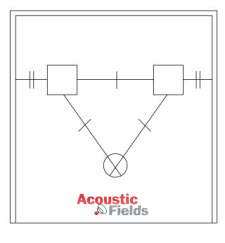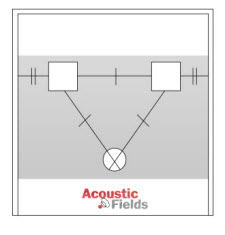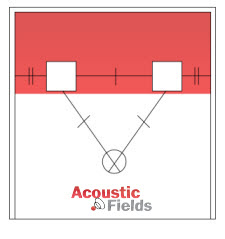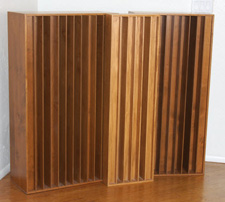It’s the time of year for saving money!
Our two-channel systems can create magic in our homes. They can generate a soundstage that has width, height and even depth. They can also show a separation and layering to all the sounds in a mix and connect with our emotions like nothing else in this world can. To achieve this beautiful bend in both time and space, many things must be known about your room. Your sound is your gear, you and your room. The three of you are married to each other. As in all relationships, there are things that are flexible and those that are not. So the following are six must-follow rules in setting up your hi-fi system if you want that marriage to work the best it can.
1. Room Size And Volume
 Finding the correct ratio of width, height and depth that will produce the best sound is not really possible. All room sizes and volumes have some type of acoustical distortion that needs to be addressed. Smaller rooms cause more pressure issues while larger volumes speak to reverberation times. Your goal is to find the correct room size that will minimize the issues you will face for your particular room usage. What size do you need so you can hear everything? If you are stuck with this room size, how bad is it and can you make it better without doing any harm? How do you live in your room and listen to quality music reproduction?
Finding the correct ratio of width, height and depth that will produce the best sound is not really possible. All room sizes and volumes have some type of acoustical distortion that needs to be addressed. Smaller rooms cause more pressure issues while larger volumes speak to reverberation times. Your goal is to find the correct room size that will minimize the issues you will face for your particular room usage. What size do you need so you can hear everything? If you are stuck with this room size, how bad is it and can you make it better without doing any harm? How do you live in your room and listen to quality music reproduction?
2. Sound Triangle
 Treat your speakers and listening position as a “sound triangle” and set these three components up correctly within your room. To start, make sure that the distance between your speakers and the distance from your speakers to the listening position are the same. The side wall distances will be different, usually less. However, whatever the speaker to side wall distance ends up being, the distances from the left and right speakers to their nearest side wall must be equal. It is also welcome to have the same wall surface and density. Side wall reflections are responsible for many things that occur on your soundstage.
Treat your speakers and listening position as a “sound triangle” and set these three components up correctly within your room. To start, make sure that the distance between your speakers and the distance from your speakers to the listening position are the same. The side wall distances will be different, usually less. However, whatever the speaker to side wall distance ends up being, the distances from the left and right speakers to their nearest side wall must be equal. It is also welcome to have the same wall surface and density. Side wall reflections are responsible for many things that occur on your soundstage.
3. Side Wall Tuning
Instrument and voice definition, central image focus and soundstage width are all benefits derived from treating the side wall reflections with respect. Using the direct or straight line sound from your speakers as the starting point, we manage the reflections so they arrive at your ears 10 to 20 milliseconds after the direct sound from the speakers. It is in this time signature range that all the magic happens. Central image focus can be zeroed in, soundstage width can be expanded to include an image that extends well past the boundaries of your speakers, and definition of all instruments and vocals on your soundstage can be dialed in and better defined with proper time management of side wall reflections.
4. High Pressure Area
 High pressure areas within your living/listening rooms can be anywhere, depending on your given room size and volume. The pressure is caused by longer wavelengths that will not “fit” into your room dimensions. The area at the front of your room is the area of highest pressure in most rooms, since this is the area in which your speakers, the pressure-producing devices, reside. Since the pressure is semi-contained by the three walls that surround your speakers, special acoustic treatment must be given to this area.
High pressure areas within your living/listening rooms can be anywhere, depending on your given room size and volume. The pressure is caused by longer wavelengths that will not “fit” into your room dimensions. The area at the front of your room is the area of highest pressure in most rooms, since this is the area in which your speakers, the pressure-producing devices, reside. Since the pressure is semi-contained by the three walls that surround your speakers, special acoustic treatment must be given to this area.
5. Room Acoustical Distortions
There are four main room acoustical distortions: SBIE (speaker boundary interference effect), comb filtering, room modes and poor diffusion. Most are present to some degree in all rooms, but the one that is present in all rooms is poor diffusion. To create a diffuse sound field within a room acoustic technology, you need to satisfy six criteria. Dr. Floyd Toole, former director of research at Harman International, tells us that a truly diffuse sound field has five basic characteristics:
1) There can be no frequency or spatial irregularities.
2) Beats (irregularities) in the decay characteristics must be negligible.
3) Decays must be perfectly exponentialproduce straight lines on a logarithmic scale.
4) Reverberation times must be the same in all room positions (that’s a hard one).
5) The character of decay must be the same for all room positions, in both high- and low-pressure areas.
Creating a truly diffused soundfield is not easy but so necessary and requires a special tool.
6. Quadratic Diffusion
 Of all the numerous features that room acoustic products claim to have, we have found only one technology that can be built adn installed easily, and that will accomplish all of these sound field diffusion requirements. Quadratic diffusion is a time-tested, proven method of diffusion that can be easily built or purchased and used in your living/listening room. Quadratic diffusers can be made out of the finest woods to compliment any existing decor. Placing them on the front and rear walls can add spaciousness, definition and clarity to your room sound.
Of all the numerous features that room acoustic products claim to have, we have found only one technology that can be built adn installed easily, and that will accomplish all of these sound field diffusion requirements. Quadratic diffusion is a time-tested, proven method of diffusion that can be easily built or purchased and used in your living/listening room. Quadratic diffusers can be made out of the finest woods to compliment any existing decor. Placing them on the front and rear walls can add spaciousness, definition and clarity to your room sound.
In Summary
Creating a soundstage that has a width, height, and depth in your living/listening rooms presents certain challenges. There are many things that have to be done correctly to achieve this. Room size, speaker/listening position placement, pressure and reflection management, along with diffusion, to make your room’s walls go away, must be taken into account, planned for, and implemented. All good relationships have a cost.






Unfortunately very few hifists have equal walls in terms of material and diffusion. That means the rule of the equal distance between walls is irrelevant, moreover it makes the listening experience very boring if the bass response with the walls is too light. From experience in a domestic room (not a room full of professional diffusors), speakers should be first placed in such way to obtain the correct level of bass for a musical enjoyment, and then adjustment is made for the visual experience (echoe and imaging).